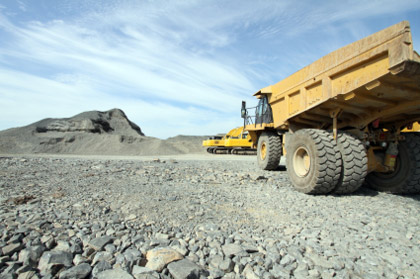Building Better Roads
Years ago, leading geologists ridiculed naturalist John Muir’s observations that persistent forces of water were responsible for carving Yosemite Valley. Just as the presence of glaciers one million years ago in the Sierra Nevada was apparently a mystery to most, the mechanisms of water movement through road and earthwork structures are similarly not immediately obvious, thus creating barriers to better, more sustainable roads. Most people understand that rainwater and snowmelt slowly soaks through asphalt pavements and moves downward through cracks in asphalt, joints in concrete pavement and road shoulders into the aggregate base course layer and embankment soils below the pavement. What is less well understood is that significant fluctuation in moisture content of aggregate base course and subgrade soils occur as the result of mechanisms other than rainwater.
Capillary attraction moves water upward through the pavement structural section from groundwater sources while water at the pavement surface is evaporated by atmospheric effects, such as high winds and hot dry weather. Road structures lacking a high degree of stiffness are repetitively flexed under the dynamic loading of automobile and truck traffic passing above. This creates a pumping action on the ground below, which serves as a second driving force to move groundwater up into and though the pavement structure.
Vice versa, during long periods of dry weather when pavement structural sections and subgrade soils have been desiccated by continuing moisture loss, suction forces pull atmospheric moisture from the air on humid days into the road structure and subgrade below. Suction and capillary attraction are transporting water up and down through the road structure at an extremely slow rate of flow, but these forces are very persistent. They cause widespread pavement failures that may seem mysterious to those less familiar with the mechanisms of water flow through soils. The culprit is basically invisible.
Reports from road maintenance crews working in semi-arid climates illustrate this phenomenon. In areas where groundwater sources are hundreds of feet below road elevation and beyond the pull of capillary attraction, despite no rainfall having been recorded for many months, repair crews find sections of failed asphalt pavement underlain by aggregate base course materials saturated by atmospheric effects and weakened as a load bearing layer because of excess moisture content.
Identifying Water as the Culprit
The relationship of water within the structure of a soil or aggregate material is fundamental to the material’s strength and stability. Add enough water and soil can transform from a solid to plastic state or even become liquid. The strongest and most stable soil or aggregate material will be one that is highly compacted at a moisture content significantly less than saturation – the point where all air in the void structure of the soil or aggregate has been completely replaced by water.
An Optimum Moisture Content (OMC) can be determined for each soil and aggregate material. At OMC, the soil or aggregate material will be very close to its highest degree of strength and stability. If the moisture content could be maintained at or near this optimum point, then subgrade and base course failures would be almost non-existent. As geotechnical engineers often joke, without fluctuations in water content under roads and buildings, they would be out of a job. Stabilizing moisture content near the optimum point is clearly the most direct route to prolonging pavement smoothness and service life.

© iStockphoto.com/kozmoat98
Put in simple terms, three basic categories of design theories exist for how best to accommodate water interactions within a road or highway structure. The first assumes that if contractors compact the soil subgrade, stack on a thick enough layer of crushed rock and an asphalt or concrete pavement surface course, they have done their job. Other than elevating the road and constructing the conventional drainage structures, no further thought is given to counteracting seasonal fluctuations in moisture content and load bearing strength of the pavement structural section. Water will be allowed to move through this road structural section at a very slow rate of flow. This is the most conventional and simplest type of road to design and construct, but seasonal increases in moisture content of the base course and subgrade reduce stiffness and stability. In cold regions, this water trapped beneath the pavement during freeze-thaw cycles generates frost heave and weakening in the base layer, thus accelerating rate of pavement failure and seasonal pothole epidemics so familiar to road users.
The second design theory takes a pro-active design approach to the water problem. The pavement structures are designed to facilitate water flow through the base course as rapidly as possible. Fast-draining base courses constructed with open-graded aggregate materials often include drain systems to capture the water and transport it away from the road structure to drainage ditches. Open-graded aggregates lack binder materials and have relatively low tensile strength, thus making it often difficult for contractors to work on top during paving operations. Subsequently, expensive measures, such as cement treatment, are often employed to increase strength and to provide a satisfactory paving platform. This brings in new potential problems related to the shrinkage, cracking and rigid nature of cement-treated materials. Cracking in the cement-treated base layer can generate reflective cracking in asphalt pavement surface course layers. Excessive rigidity in the base layer can be counter-productive to the durability of concrete pavements undergoing repetitive loading under heavy truck traffic.
Practitioners of fast-draining, open-graded aggregate base layers are known to describe conventionally designed roads as the world’s longest bathtubs, based on the fact that they trap and hold water. Be that as it may, open-graded aggregate materials or drainage systems associated with these fast-draining roads often plug, thus turning the road structure into the same virtual bathtub and equally leading to pavement structure failure. Although these fast-draining base courses are designed to accelerate water flow through the base layer, they leave the subgrade fully exposed to atmospheric effects and ongoing wetting and drying cycles, which generates volume change and movement in soils below the road and contributes to rougher running pavement.
Understanding the Moisture Barrier Approach
Rather than allowing access to destructive water mechanisms, as in conventional road design, or intentionally flowing water through road structure in fast-draining design, the moisture barrier approach of the third design theory aims to keep excess water entirely out of the road structural section. Modern product technology is available to solve the water problem. Stabilized road structural sections can and are being constructed that remain in permanently unsaturated condition. Lower permeability stabilized aggregate and soil materials shed surface water off the road to adjacent drainage ditches.
Stabilized layers can function as effective moisture barriers within the road structural section, thus isolating road materials and native subgrade soils from atmospheric effects and effectively eliminating driving forces for capillary attraction and upward movement of groundwater. These stabilized base layers remain stiff and strong while resisting fluctuations in moisture content. The moisture barrier effect helps further protect against roughness in the pavement by promoting a more consistent and stable moisture distribution in the untreated native subgrade below the road. This is a multiplier effect of the moisture barrier design concept that neither conventional nor fast-draining road design theories can achieve.
A more stable native subgrade contributes to a smoother running pavement. Pavement smoothness is the most recognized evaluation of pavement performance. Rough pavements lead to higher dynamic loads, which speeds up pavement deterioration. This not only lowers ride quality and increases fuel consumption, but also leads to a cycle of ever rising deterioration rates with intensifying roughness severity. Conversely, a smoother running pavement will have an extended service life and reduce fuel consumption. Less well studied, but with even greater potential for fuel saving, are the millions of miles of unpaved gravel and dirt roads where low cost upgrades to running surfaces could potentially double the gas mileage of vehicles driving on these stabilized roads. Better roads make more efficient use of road construction dollars while reducing fuel consumption and environmental impacts without a requirement for additional effort or investment from road users.

© iStockphoto.com/trekandshoot
Adopting Better Solutions
If these benefits are available as described above and it is just a matter of changing design methods, which rely on stabilization product technology with a demonstrated ability to keep water out of road structural sections, why hasn’t this approach already become dominant in actual practice? The answer is both simple and complicated, and it starts with engineering design theories and material testing procedures developed early in the last century that were subsequently promulgated via text books and public agency design manuals across the nation.
The highway engineering community is largely reliant upon the first two design theories described above, which allow water to move through the pavement structural section at varying rates of speed. These design methods were based upon the teaching of Saturated Soil Mechanics theory in the 1930s, which was reliant upon the results of index measurements taken from laboratory test methods. When Saturated Soil Mechanics theories were based upon the results of saturated laboratory index tests and incorporated in road agency design manuals, the only reality became the laboratory test result. These saturated design theories and test methods are still built into most public road agency design manuals across the country.
The problem is that there was no direct correlation with the field service environment. In this world where unsaturated conditions typically predominate, saturation of the road structural section was assumed by the highway industry to be inevitable. For open-draining aggregate materials or drainage products, the door was open. On the other hand, when it came to adopting product technology that was effective in keeping water out of their highway designs, the industry reacted as if it were being asked to fit a square peg into a round hole.
Unsaturated design approach for moisture barrier stabilization technology has been in use throughout the past several decades. Highway industry practitioners have had a conceptual barrier to utilizing design concepts familiar to the waste containment industry, where the assumption is that you can and will solve the moisture problem by keeping water out of the structure. The goal is to effectively maintain the structure and its contents in an unsaturated state.
Mirroring John Muir’s Experience
Any new theory or technology will have the challenge of overcoming current thinking and practice. Where modern technology is available to solve problems, outdated design methods only assure failure. Fortunately, the theory of Unsaturated Soil Mechanics is now being taught, thus providing the conceptual framework for testing and design methods that assume road materials will exist for much or all of their service life in an unsaturated state. From this perspective, testing and design can better model environmental conditions in the actual road environment.
Products effective in protecting the unsaturated state of the materials can be assigned priority status over products that show impressive strength values in saturated tests but have little or no value in stabilizing the moisture regime in the pavement structural section. Abandonment of some strongly held theories and ingrained practices may be required, but there is light at the end of the tunnel. As John Muir could testify if he were still with us today, progress in some fields may come at a glacial pace but with continued gathering of field evidence and scientific observation, the better answer will have its day.




























